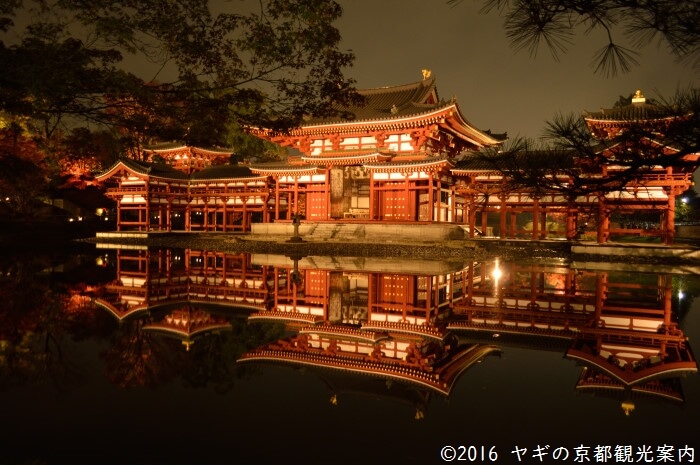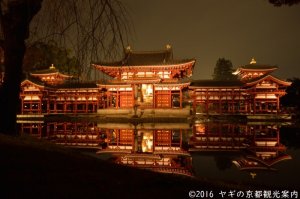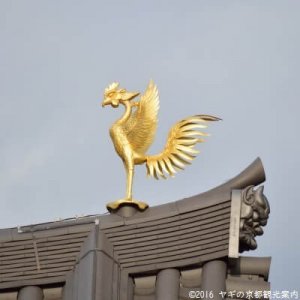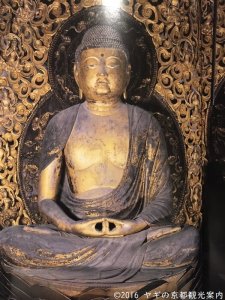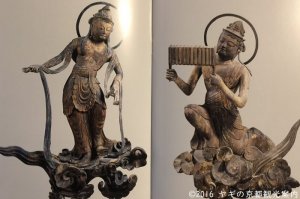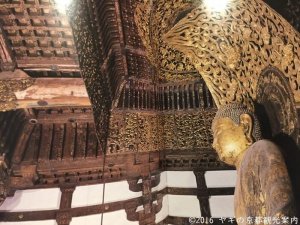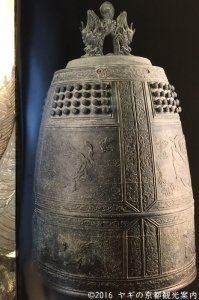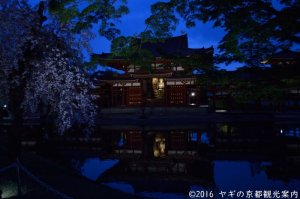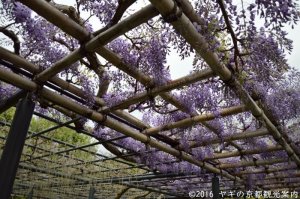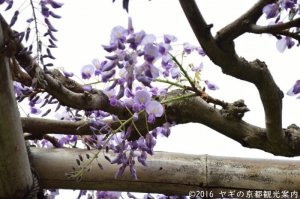A short history of Byodo-in temple
The history of Byodo-in temple dates back to the 9th century.
A villa built by Minamoto no Wataru, the son of the Emperor Saga, is the origin of Byodo-in temple. In the 10th century, Fujiwara no Michinaga, the most prosperous court noble in Japanese history, inherited and developed it into his villa “Ujidono.” When he passed away, his son Fujiwara no Yorimichi converted it into a Buddhist temple.
In the 10th century, the court nobles were at the height of their prosperity but they had some worry despite their wealth: the Year 1052 problem, or Mappo Shiso (末法思 The decline of the Buddhism).
It was believed that the Buddhism went into decline 2000 years after the decease of Gautama Buddha. In addition to it, there were many natural disasters and epidemics at that time. They feared that the world was on the verge of ending and wished to be reborn in the Western Paradise in the Pure Land Buddhism.
The Western Paradise is a kind of paradise or heaven which Buddha (the word means “Enlightened Deity of person.”), and Bodhisttava (Deity or person in practice to be Buddha) rule. We have nothing but infinite happiness there. For the sake of creating it in the world the court nobles lived in, they founded many temples enshrined Amitabha or Amida Buddha.
Under such circumstances, the construction of Byodoin started in 1052. After the establishment, it experienced many natural disasters and even became a battle field. Only the Phoenix Hall survived them and listed in the list of the world heritage site in 1994.
The architecture of the Phoenix Hall
Inside of the Phoenix Hall
Attention: We are prohibited to take pictures in the Phoenix Hall. The pictures of Amitabha in this aricle are photos of the brochure I bought.
The architecture 鳳凰堂
A building we know as Byodo-in temple is called the Phoenix Hall. It enshrines Amida Buddha(阿弥陀如来). It is constructed in 1053 and not called the Phoenix Hall (鳳凰堂) in the early days. It is called Amidado(a hall enshrines Amitabha) or Mido (a hall endhrines Deity). In a document written in Edo period, the name “the Phoenix Hall” appears for the first time.
There are two reasons for the name; the one is a pair of birds on the top of the roof and the other is an appearance of the hall: These birds are Phoenix and the hall has symmetric construction and reminds us of the bird.
The Phoenix hall is located on a pond. It is based on Amitayurdhyana Sutra ( 『観無量寿経』), the teaching of the Pure land Buddhism. It tells us that: 若欲至心生西方者、先当観於一丈六像在池水上 ( If you wanted to be reborn in the Western Paradise, see a small statue (of the Amitabha.) on a pond. A hall is located on a pond and they make a garden. This is Jyodo-style garden(浄土式庭園).
The hall is one of rare architectures built in Heian period (794 – 1185). Many people see Kyoto associating with the period and believe many Shinto shrines and Buddhist temples were built at that time. The truth is that many of them were constructed in Edo period (1603– 1868) because of Ohnin no ran, the largest civil war lasted for 10 years and many fires burnt out Kyoto city. The Phoenix Hall is one of the rare examples which survived these disasters. See the head of 10 yen coin, and you will find the Phoenix Hall.
Phoenix (National treasure) 鳳凰
Phoenix (鳳凰) is an imaginary bird who appears a great ruler was born and birngs us prosperity. The word 鳳 means male Phoenix and 凰 means female one. This distinction depends on Japanese Yin-yang philosophy: two imperfect things help each other to be perfect and infinite.
On the roof of the Phoenix Hall, we can find them glittering gold against the sky. They are extraordinary works but are replicas. The authentic ones are kept in Hoshokan Museum. They are made of gilt bronze and covered green rust. The height is about 3 foot. They wear globe-shaped ornaments on their necks. They are Hoju (宝珠) which saves us from bad luck and gives us anything we want. See 10,000 yen bill. We can find one of them.
The statue of Amida Buddha (National treasure) 阿弥陀如来立像
Inside of the Phoenix Hall, there is a statue of Amitabha, the Deity who has infinite light and rules the Western Paradise in the Pure Land Buddhism. It is made by Jocho(定朝), one of the most outstanding sculptor in Heian period. He is known as the master of Yosegi-zukuri style statue. In Yosegi-zukuri style, sculptors join pieces of woods together and make one statue. A statue made of one piece of wood is tend to be changed in its shape because of bending of the piece. Yosegi-zukuri style prevents the effect from statue.
The statue has eyelids half opened: The Hangan (半眼) eyes which means a complete calmness and concentrated state of mind.
Take a look at the hands. They make a kind of sigh language. The form of them is Amidajohin(阿弥陀定印). It reveals that Amitabha is in meditation and has strong will to save us.
Behind the statue, there is an aureola called Kohai(光背) which stands for the truth the Buddha tells us. We can find many statues of Bodhisattva on clouds on the surface of it. They are Hiten(飛天) which worship Amitabha. This kind of Kohai is called Hitenko(飛天光), the style invented by Jocho.
The statue is seated on a huge lotus. It is called Rengeza(蓮華座). Lotus is a flower we find in the Western Paradise. Lotus has its roots on muddy water and blooms a beautiful flower over surface of water. It is considered as a symbol of the truth and mercy in the Buddhism.
Praying Bodhisattva on clouds (National treasure) 雲中供養菩薩像
On the walls on the Phoenix Hall, there are 52 statues of Bodhisattva. Some has a musical instrument and some has flower in their hands. It is believed that they descend from the Western Paradise with Amitabha to bring us there. They were originally painted in Gokusai shiki, Japanese vivid colors found in Buddhist temple, but 1,000 years of history made it faded away completely. At the entrance of Hoshokan museum, there is a re-painted replica of it. The half of the authentic ones still hang on the wall of the Phoenix Hall, and we can see the rest in the museum.
Canopy/Tengai ceiling (National treasure) 天蓋
There are many incredible woks on the ceiling of the Phoenix Hall.
The paintings in the Phoenix Hall
There are paintings on the walls on the Phoenix Hall: The Kuhon raigo zu (九品来迎図).
Kuhon is nature of thing and devided into three; Jyobon, Chobon, and Gebon. Each bon are devided into three again. In Kuhon raigo zu, nine Amitabha represents each bon descend from the Western Paradise when we pass away.
Hosho kan museum 鳳翔館
What is Hosho kan?
Hosyokan is a museum belongs to Bydo-in temple. In its superb, highly sophisticated construction, it exhibits many statues, artworks, and debris excavated around Byodo-in temple.
Bonsho (National treasure) 梵鐘
Bonsho is Buddhist bell. It is usually rang as a prelude of prayer or sermon. It is believed that its sound save us from suffer and lead us to the truth. The Bonsho of Byodoin temple has one of the most exquisite relief work in Japan. The replica is located outside of the museum.
Bodhisattva on clouds (National treasure) 雲中供養菩薩像
As we discussed before, there are 26 statues of Bodhisattva in the museum.
Illumination in Byodo-in temple
In spring and fall, we can visit Byodo-in temple. We can’t enter the Phoenix Hall but admire it in the garden. In Spring, we can enjoy it with cherry blossom trees. In fall, there are many autumn leaves.
Wisteria in Byodo-in temple
Byodo-in temple is famous for amazing wisteria. Flowers are on a grid called Fujidana (藤棚). It is trellis for wisteria. In Japan, it was invented to admire the flower. It gives the flower delicate impression.
How to get to Byodo-in temple?
Map
From JR Uji station
It takes about 25 minutes from JR Kyoto station to JR Uji station. From JR Uji station, after about 15 minutes walk, we can get to Byodo-in temple.
From Keihan Uji station
It takes about 30 minutes from Keihan Gion shijo station to Keihan Uji station. Change train at Chusyojima station. From Keihan Uji station, after about 10 minutes walk, we can get to Byodo-in temple.
About Byodo-in temple
Official name
Asahizan Byodo-in 朝日山平等院
Address
Renge-116 Uji, Kyoto Prefecture 611-0021
Phone no.
0774-21-2861
Website
Byodo-in temple official HP(English)
Open hours
The garden
8:30~17:30 (The gate closes at 17:15)
The Phoenix Hall
9:30~16:10
Small tour departs in every 20 minutes. Each tour allows up to 50 persons but by 14th September, up to 25 persons.
Entrance fee
Adult: 600 yen. High school and junior high school student: 400 yen.
Elementary school student: 300 yen
Time required
1 hour~
ヤギの京都観光案内/KYOTO GOAT BLOGをもっと見る
購読すると最新の投稿がメールで送信されます。

